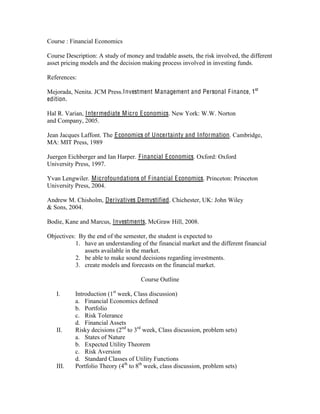
Financial economics new syllabus
- 1. Course : Financial Economics Course Description: A study of money and tradable assets, the risk involved, the different asset pricing models and the decision making process involved in investing funds. References: Mejorada, Nenita. JCM Press.Investment M anagement and Personal F inance, 1st edition. Hal R. Varian, Intermediate M icro E conomics. New York: W.W. Norton and Company, 2005. Jean Jacques Laffont. The E conomics of Uncertainty and Information. Cambridge, MA: MIT Press, 1989 Juergen Eichberger and Ian Harper. F inancial E conomics. Oxford: Oxford University Press, 1997. Yvan Lengwiler. M icrofoundations of F inancial E conomics. Princeton: Princeton University Press, 2004. Andrew M. Chisholm, Derivatives Demystified. Chichester, UK: John Wiley & Sons, 2004. Bodie, Kane and Marcus, Investments, McGraw Hill, 2008. Objectives: By the end of the semester, the student is expected to 1. have an understanding of the financial market and the different financial assets available in the market. 2. be able to make sound decisions regarding investments. 3. create models and forecasts on the financial market. Course Outline I. Introduction (1st week, Class discussion) a. Financial Economics defined b. Portfolio c. Risk Tolerance d. Financial Assets II. Risky decisions (2nd to 3rd week, Class discussion, problem sets) a. States of Nature b. Expected Utility Theorem c. Risk Aversion d. Standard Classes of Utility Functions III. Portfolio Theory (4th to 8th week, class discussion, problem sets)
- 2. a. Risk and Return b. Diversification (Risk Aversion and Capital Allocation) c. Optimal Risky Portfolio d. Index Models IV. Fixed Income Securities (9th week, classroom discussion) V. Capital Asset Pricing Model (CAPM) (10th to 11th week, classroom discussion, problem sets) VI. Asset Pricing Theory (APT) (12th week, classroom discussion) VII. Macroeconomic Analysis (13th week, class room discussion) VIII. Options/Futures/Swaps (13th week to 14th week, classroom discussion) Consultation Hours: 2:00 -2:30 TTH
